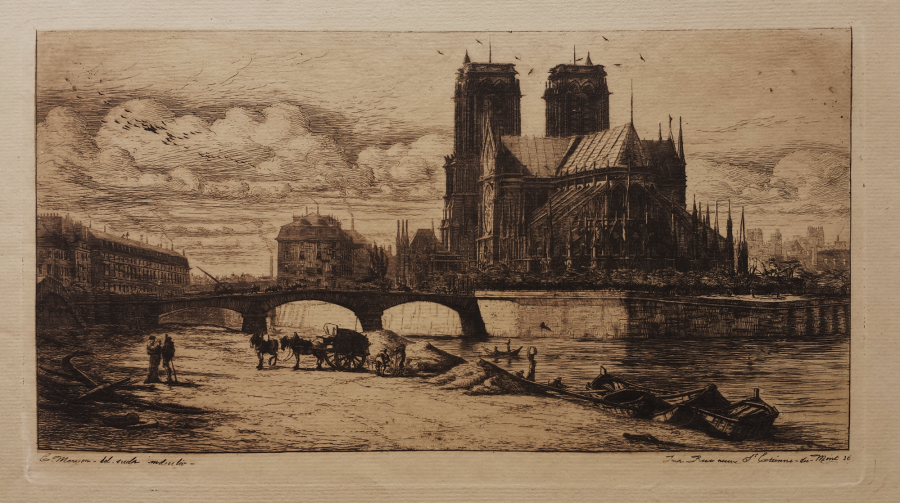[The Apse of Notre-Dame de Paris]
Etching and drypoint, 150 x 289 mm (subject) 165 x 298 mm (plate). Delteil 38 IV/VIII; Schneiderman 45, IV/IX. Impression of the 4th state (of 9) before the date was erased and the houses burnished at right.
A superb and rare impression printed in dark brown ink on thick ivory laid paper with watermark (shild and date 1852). Sheet: 320 x 465 mm.
In the inventory of Meryon's prints gathered by the Duke of Aumale and bequeathed by him to the Institut de France with all his collections to be turned into the Musée Condé in Chantilly, Antoine Cahen lists three impressions on paper with 1852 watermark: Tourelle, rue de la Tixeranderie (S. 24 iii/v), impression printed in brown ink on laid paper (400 x 270 mm, watermark: 1852 (inv. Est. 327); La Pompe Notre-Dame (S. 26 vii/x), impression printed in brown ink on laid paper (320 x 375 mm, watermark: 1852) (inv. Est. 328); Le Pont-au-Change (S. 40 vi/xii), impression printed in brown ink on laid paper (320 x 488 mm, watermark: 1852), annotated verso « 1er état / et 1er état du ballon / N°48 » [1st state/and 1st state with the hot-air balloon], stamp «A.P.» (inv. Est. 324). (A. Cahen, Meryon at Chantilly, Print Quarterly, vol. 21, no. 4, December 2004, pp. 421-430).
L’Abside de Notre-Dame de Paris is the plate no.12 from Eaux-fortes sur Paris published by Meryon in three issues between 1852 and 1854.
‘A sheet of small pencil sketches for portions of the etching’ belonging to F. Seymour Haden and a pencil drawing of L’Abside de Notre-Dame de Paris from the collection of M. Niel, lent by the Rev. J. J. Heywood are mentionned in the catalogue of the Exhibition of a selection from the work of Charles Méryon, Burlington Fine Arts Club, 1879, No.69, 70, p. 34.
Campbell Dodgson, who was the keeper of the prints and drawings at the British Museum in 1921, judged L’Abside de Notre-Dame de Paris to be a ‘’justly famous masterpiece’’ and described it with enthusiasm: ‘’The design of the whole plate, the lighting of the sky and of the side of the majestic cathedral, the proportion of the towers and highpitched roofs of Notre-Dame to the massive but comparatively insignificant buildings along the line of the Seine combine to produce a total effect of unrivalled dignity and charm. How eloquent, too, is the contrast of all that splendid architecture across the river with the squalid foreground, where heaps of sand are being shovelled into carts, and barges of the humblest kind are moored along the shore.’’ (Campbell Dodgson, The Etchings of Charles Meryon, Geoffrey Holme, London, 1921, p. 18). He forgot the washerwomen at the river’s edge and the couple talking on the dock, with the woman holding a child in her arms.
Loys Delteil also said that L’Abside de Notre-Dame de Paris was regarded as Meryon’masterpiece: ‘’Among Meryon’s etchings, l'Abside de Notre-Dame de Paris, or simply l'Abside for those familiar with the work of Meryon, is the most famous in the world of the amateurs of prints, in America as well as in England or France. This piece is prized in relation to its amiable appearance and for the harmony of all its parts, although the sky is, as in the other etchings by Meryon, engraved with a solidity which which, by the way, does not jar with the whole, because of the will that it encloses, and leaves the work perfectly homogeneous. » (L. Delteil, 1927, p. 21).
Meryon had however probably a less calm and harmonious view of his work, as suggested by the lines he etched on another plate to go with L’Abside de Notre-Dame de Paris: ‘’O thou who lovest every bit of Gothic, behold here the noble basilica of Paris. Our great and pious kings built it as a testimony to their Master of their profound repentance. Althoug very massive, alas, it is said to be still too small to hold even the elite of our least sinners.’’ (Translated by Schneiderman, p. 95). [0 toi dégustateur de tout morceau gothique/ Vois ici de Paris la noble basilique./ Nos Rois, grands dévots, ont voulu la bâtir / Pour témoigner au Maître un profond repentir./ Quoique bien grande, hélas ! on la dit trop petite,/ De nos moindres pécheurs pour contenir l'élite.] (Delteil 39; Schneiderman 46)
References: Campbell Dodgson, The Etchings of Charles Meryon, Geoffrey Holme, London, 1921; Exhibition of a selection from the work of Charles Méryon, Burlington Fine Arts Club, 1879; L. Delteil, Le Peintre-Graveur illustré, tome second, Meryon, Paris, 1907; L. Delteil, Meryon, Rieder, 1927; R.S. Schneiderman, Charles Meryon, The Catalogue Raisonné of the Prints, Garton & Co., London, 1990.
Price: 12000 EUR // 14000 USD



